Universe Expansion Calculator
There's nothing that unites humanity more than the awe we feel when we look up at the stars and admire the beauty of our amazing Universe. With NASA's budget rising to over $22Billion in 2020, and the space industry nearing the trillion dollar mark, it is surprising that most of us don't know much about how the universe was formed, what it's made of of, and how we even got here.
Enter the Universe Expansion calculator. A simple tool that helps you find all these answers in a fun and interactive way. Create your own universe, see how each component affects its fate... all while learning the scientific reason behind why our universe is like it is.
Did you know that without dark energy, our universe would be much smaller? It might even collapse back into a single point and sort of "reincarnate" itself as a second Big Bang creating a new universe... Is this enough to pique your interest? Come in and answer your questions about the universe!
What is the universe? / How to describe the universe with maths
The universe is everything. It is made of many different components, such as stars, light, x-rays, planets, gas clouds, and black holes... Which makes it difficult to be modeled mathematically.
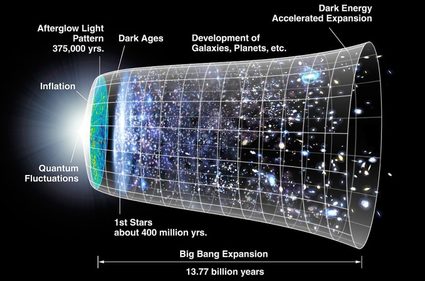
Astronomers have found ways to divide the constituents of the universe into 4 major groups. These four major components are:
- Matter;
- Radiation;
- Dark energy; and
- Spatial curvature.
Additionally, there is another parameter that measures the expansion rate of the universe: the Hubble constant ().
Each component of the universe affects its evolution in a different manner, described by Friedmann's equations – a set of formulas that explain most of the phenomena we see in the universe. They allow us to observe the effects of each component separately and get a better picture of what their role is in the evolution of the universe.
Hubble constant ()
When astronomers first saw all the galaxies around us, they discovered that all of them seemed to be moving away from us. In fact, the speed at which they "run away" from us is proportional to the distance between us and them (our acceleration calculator can help clarify the meaning of this sentence). The only possible explanation for this is that the whole universe is expanding, like a piece of fabric getting stretched. The first one to notice this? Edwin Hubble (and also George Lemaitre). The key to this discovery was the evidence of Doppler effect in the data from far galaxies: use our dDoppler effect calculator and our redshift calculator for more information!
This expansion of the universe was thought to be constant (now we know that its expansion is accelerated), and the value of this constant speed was, understandably, named after Dr. Hubble. Measuring it by looking at distant galaxies yields a value of per . If you look at the remnants of the Big Bang, Hubble's constant is per .
We know the discrepancy is not due to experimental error, so what gives? There must be a hole in our knowledge of the universe that we must fix! There isn't anything more frustrating and yet exciting for physicists and space lovers alike.
In this calculator, we use per but can set it to per to see what this difference means for the evolution of the universe.
Effects of Dark Energy ()
Dark Energy is more complicated to understand than the other components. Not even cosmologists know what it really is, and it only has an effect when considering very large scales.
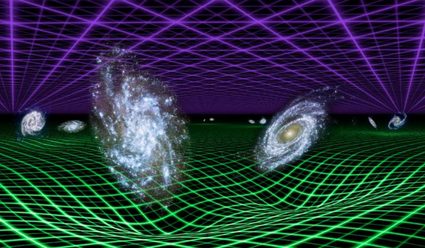
Dark energy, identified in cosmology by the Greek letter Lambda (Λ), is responsible for the accelerated expansion of the universe we experience in our reality. Dark matter makes space expand exponentially, so it's effects will only become noticeable after billions of years.
On the other hand, nothing prevents Dark Energy from making space compress exponentially. One can easily imagine such a scenario: would be negative and the universe would contract and collapse into a single point.
Effects of Matter ()
Matter is a more understandable component of the universe. Sort of. It is composed of two major types: (cold) dark matter and regular (or baryonic) matter. We still don't really know what dark matter is, but we know that it represents about 90% of all matter in the universe. Fortunately, all matter behaves mostly the same.
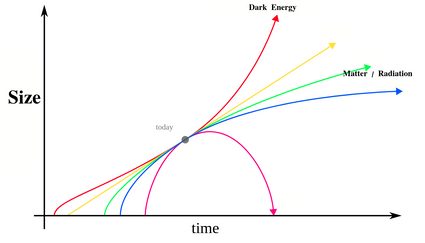
Its effect on the evolution of the universe is almost the opposite to that of dark energy. A universe composed of mostly matter would expand very rapidly at the beginning and will slow down as years pass. For a visual representation, check the green line of the image above.
Effects of Radiation ()
Similar to matter, radiation is another concept that we use in our everyday life. Think UV radiation, gamma rays, infrared... In short: light. On top of light (photons), neutrinos are also considered to be radiation for our purposes since they have the same effects.
The way photons and neutrinos interact with the expansion of the universe are qualitatively similar to how matter does it, as it is the blue line in the image above. Radiation makes the universe expand faster than matter does, at least at the beginning.
You can learn more about the effects of radiation in space with our radiation pressure calculator.
Curvature density () and the shape of the universe
There is one last parameter we must talk about: the curvature density (). If , we have a closed universe that tends to collapse again onto itself. For , we have an open universe that tends to expand forever. And for , we have a flat universe with no spacial tendency to expand or contract.
We have to remember that this is only a simplistic explanation, and the actual outcome of any given universe will depend on the values of each of the four parameters. However, all this knowledge should be enough for you to be able to play around with the calculator and get a grasp on the impact that each parameter has on the evolution of the universe.
Our universe
Currently, the most accurate description of the universe we have is what it's known as the ΛCDM model. According to this model, the main components of our universe are dark energy (lambda, Λ) and cold dark matter(CDM), with regular matter in a distant third position. The widely accepted values for each component are:
-
Dark energy : or ;
-
Matter : or ;
-
Radiation/light : or ;
-
Curvature density : (flat universe); and
-
Hubble constant : per .
As you can see, most of the parameters of the universe do not have units. They represent a fraction or percentage of a reference quantity, called critical density.
These parameters are constantly being measured with increasing precision by astronomers, so you might find different values depending on your source of information. A very renowned source is .
From the birth of the universe (Big Bang) until now
We know that at some point in time, the universe was condensed into a point of infinite energy density. This is what we call the Big Bang, which is when time itself started. There was no actual explosion, but rather an incredibly fast expansion that led to what we now know as the universe.
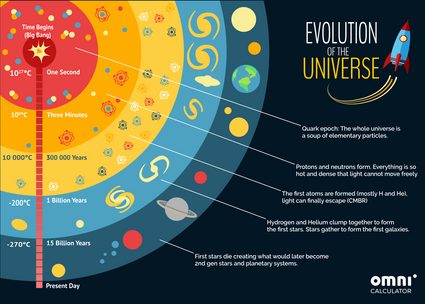
As the universe expanded and cooled, the forces began to distinguish from each other, and complex particles began to form. First protons and neutrons, then nuclei, atoms... This was a fast process (on an astronomical scale) – it took the universe over 300 000 years to become cool enough for radiation to be able to travel any meaningful distance. We actually have a picture of this moment. This information is still around today as the cosmic microwave background (CMB), which is a faint microwave signal that we detect coming from everywhere in the universe. It is the oldest piece of information we have from the universe.
The universe underwent a relatively short phase of radiation-dominated expansion at the beginning of its life. This was quickly succeeded by a matter-driven expansion phase. Currently, however, the expansion of the universe is dominated by dark energy.
You can see these different phases on the calculator by selecting Our Universe. The very first part of the chart is a quick expansion driven by radiation. The second phase (matter-dominated) blends in, and it's hard to distinguish from radiation, but the expansion is noticeably slower. Finally, for age more than 10 Billion years old, one can see a subtle change from an almost linear expansion to an accelerated (exponential) expansion due to dark energy.
The possible deaths of our universe
Now that we know how we got here, you are probably wondering what the future holds. We won't live to see the universe end, but it's fun to explore. The abundant presence of dark energy almost entirely rules out the possibility of the universe collapsing back into a Big Crunch and potentially creating a new Big Bang in a sort of reincarnation.
The abundant presence of dark energy almost entirely rules out the possibility of the universe collapsing back into a Big Crunch. For the same reason, the universe's expansion cannot slow down to a halt, leaving just two possible scenarios.
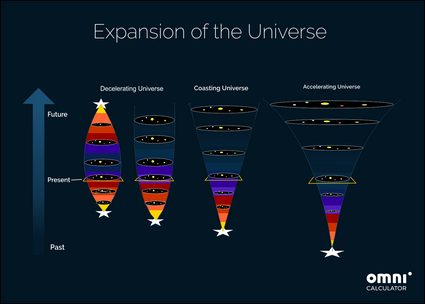
The so-called cold death of the universe is a scenario in which the universe keeps expanding faster and faster. So fast, in fact, that it overcomes the gravitational attraction between galaxies, stars, and planets... Eventually, every object in the universe ends up alone, infinitely far from everything else: cold, silent, until it all dies out in, quite literally, empty space.
There is a less depressing option — a Big Rip could happen. In this scenario, the universe expands so fast that, at some point, it tears the fabric of space–time. What would it look like? We don't really know, and we have no way to test it. Fortunately (or unfortunately, depending on your curiosity), none of us would be there to see it – and neither will anything currently living on planet Earth.
How to build your own universe
If you feel overwhelmed having to create your own universe, here are some practical tips and tricks:
-
A large amount of dark energy will result in exponential growth at the end of the graph (after at least 10 billion years).
-
A large amount of radiation will create a very rapid expansion at the beginning and might overshadow any matter or dark energy contribution.
-
Matter behaves somewhat similarly to radiation but with milder effects.